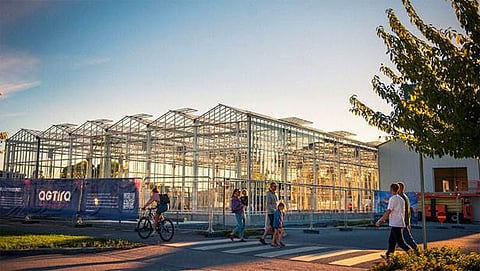

The ICA Maxi Supermarket in Östersund will have its own fishfarm and greenhouse, developed by Landing Aquaculture in partnership with AGTtira.
Photo: Landing Aquaculture / AGTtira.
A supermarket with its own on-site fish farm and greenhouse, supplying its customers with homegrown fresh salmon, together with tomatoes, cucumbers, and microgreens?
That’s the innovative idea being made into reality by a new collaboration between Landing Aquaculture and AGTtira: the CityFarm project in Östersund, Sweden.
Landing Aquaculture BV has designed a compact Recirculating Aquaculture System (RAS) for the project – the company’s most compact design yet - which aims to house up to 34,000 salmon, and produce up to 8 tons of premium fish fillets.
The system's processed effluents will then be used to cultivate 100 tons of salad vegetables in an adjacent greenhouse.
Located on the site of the ICA Maxi Supermarket in Östersund, this project is a first-of-its-kind demonstrator for local food production in Sweden.
The project has proved an exciting challenge, Carlos Espinal, Landing Aquaculture's Innovation Director, told WeAreAquaculture.
The team faced several design challenges, which led them to develop innovative solutions in collaboration with Alde Akva, a consultant on the project. These include using Advanced Oxidation Process (AOP) instead of ozone for water treatment, dewatering systems on tank sidewall drains for quicker fish transport, and anaerobic bioreactors to control nutrient levels for the greenhouse.
For Landing Aquaculture, the CityFarm project presented a unique opportunity to enhance their RAS design and manufacturing capabilities, as well as showcase their ability to handle complex, larger systems, Espinal explains.
The project, a compact RAS system cultivating salmon, also incorporates aquaponics engineering, with wastewater and sludge used to fertilize crops in the greenhouse.
"The effluents of the fish house will go to the greenhouse to fertilise the crops. There's lots of nitrogen in the fish water, and you can send that to the plants. There is also a lot of phosphorus in the sludge captured by the mechanical filters, but that does not dissolve in water – it's locked in the organic matter itself. So, to make some of the phosphorous available for the plants, we are going to use a sludge bioreactor,” he said.
“When Landing started around 10 years ago, we started with a symbiotic approach to aquaponics, where the fish and plants were in an interdependent relationship. But that can be a problem, because if you lose fish, your plants starve. If you lose plants, you lose filtration for your fish.”
The company now takes what Espinal calls a “synergistic approach”, where the fish house and plant systems can operate independently but offer net benefits when combined. This includes cost savings on fertilization and other operational advantages.
“The fish house can run on its own, and the plants can run on their own, but you can make them work together to share resources. For example, you can reduce some of the costs of fertilising your plants, and you can use the heat from the greenhouse to heat your fish water, depending on the species. The fish also provide a bunch of good bacteria that help the nutrients in the organic matter become available to the plants,” he explains.
Landing Aquaculture is also exploring other ways to increase the efficiency of nutrient dissolution and apply these principles in different contexts, such as using saline sludge from marine operations to grow seaweeds and algae.
Landing Aquaculture's RAS design for the CityFarm project.
Photo: Landing Aquaculture.
The company has a history of delivering successful RAS systems, and enjoys a reputation for handling challenging projects in confined spaces, offering turn-key solutions with minimal need for subcontractors, Espinal told us.
Previous designs by Landing Aquaculture include the Landing Proof of Concept and Landing MicroRAS - but the CityFarm project is their most compact design yet, Espinal says.
“We’re building all the system components, such as tanks and biofilters, in our workshop and then we’ll assemble everything on-site in upcoming months,” he says, noting the first stocking of fish is planned to take place by summer 2024.
That means consumers in Östersund will soon be able to access completely fresh and homegrown ingredients, produced next door to where they are sold: “It’s salmon and salad, all grown on site.”
